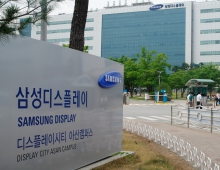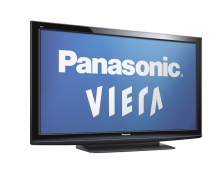
New "Telescopic Pixel" Display Technology Outperforms LCD and PDP
A high-efficiency display based on a telescopic pixel design could be a future alternative to LCD and plasma displays, offering low response times and increased brightness.
Liquid crystal display (LCD) technology is the most popular of the display/television technologies currently used in computer monitors. The other technologies in use today include organic light-emitting diode (OLED), plasma, digital light processing (DLP) and cathode ray tube (CRT) systems. However, they cannot match all the advantages of LCDs, which are thin, have high resolution, are low cost, and offer low power consumption and long lifetime. On the negative side, LCD systems do not have high contrast, because liquid crystals cannot completely block light in the off state, and are virtually unusable in the presence of bright ambient light. This last point arises because LCDs transmit only 5?10% of the backlight because of the polarizer, which blocks more than 50% of the light. Also, each colour filter transmits only 30% of the remainder of the light, and there are some additional layers that decrease transmission even further.
It is desirable to increase the efficiency of backlight transmission to decrease energy consumption and improve visibility in brighter environments. As a solution, Microsoft and Washington University Research Institute, presented a new display technology ? the 'telescopic pixel'.
The advantages of the telescopic pixel are high transmission efficiency, potentially low cost, as well as relative ease of fabrication and control.
'Telescopic' indicates that each pixel acts as a miniature telescope consisting of a primary and secondary mirror. Under applied voltage the primary mirror can change its shape from planar to approximately parabolic.
When the pixel is turned off, the primary mirror is planar. Therefore, both the primary and secondary mirror block the passage of light, reflecting it back to the backlight, so that the pixel appears dark. When the pixel is turned on, the shape of the primary mirror is close to parabolic. In this state, the mirror focuses light onto the secondary mirror. After reflecting from the secondary mirror, light propagates through the hole in the membrane and the pixel appears bright .
The use of the telescopic pixel can provide some important advantages for several applications. The three main existing types of displays are transmissive (backlight passes through the pixel), reflective (light reflects from the pixel) and emissive (the pixel itself generates light). Examples of emissive technologies include OLED and plasma. Organic LEDs are currently used in the fabrication of small screens as the contrast and colour quality of such devices are good, but present yield is low and lifetime is limited, which makes fabrication of large screens very expensive. Plasma technology, in contrast, works well for large screens, but its resolution is limited by the fact that the size of its pixels cannot be significantly scaled down. Therefore, for an application requiring large-screen, high-resolution displays, a telescopic pixel arrangement can offer advantages. The materials from which it is made are stable, and it does not suffer from resolution limitations, because its design is scalable, working well for different sizes of device. According to experiments the pixel size was 100 microm, but this can be scaled up or down depending on the desired resolution.
The first prototype's contrast ratio was 20:1, mainly due to the use of non-collimated back light. This was a limitation of the current prototype, not of the technology. This is supported by simulations, which show that a ratio of at least 800:1 is possible.
The total amount of backlight that can be transmitted by a telescopic pixel display based on the experiment is approximately 36%, and simulations show that up to 56% is possible. The current experimental value is 3.5?7 times greater than that of LCDs, and therefore for the same backlight intensity, the telescopic pixel is 3.5?7 times brighter.
It could take quite some time for the technology to reach your laptop's display - if ever. However, Microsoft's involvement to the project could leave us with some hope that Telescopic Pixel displays could find their way out from the Washington University labs. Additional information is available at Nature Photonics.
It is desirable to increase the efficiency of backlight transmission to decrease energy consumption and improve visibility in brighter environments. As a solution, Microsoft and Washington University Research Institute, presented a new display technology ? the 'telescopic pixel'.
The advantages of the telescopic pixel are high transmission efficiency, potentially low cost, as well as relative ease of fabrication and control.
'Telescopic' indicates that each pixel acts as a miniature telescope consisting of a primary and secondary mirror. Under applied voltage the primary mirror can change its shape from planar to approximately parabolic.
When the pixel is turned off, the primary mirror is planar. Therefore, both the primary and secondary mirror block the passage of light, reflecting it back to the backlight, so that the pixel appears dark. When the pixel is turned on, the shape of the primary mirror is close to parabolic. In this state, the mirror focuses light onto the secondary mirror. After reflecting from the secondary mirror, light propagates through the hole in the membrane and the pixel appears bright .
The use of the telescopic pixel can provide some important advantages for several applications. The three main existing types of displays are transmissive (backlight passes through the pixel), reflective (light reflects from the pixel) and emissive (the pixel itself generates light). Examples of emissive technologies include OLED and plasma. Organic LEDs are currently used in the fabrication of small screens as the contrast and colour quality of such devices are good, but present yield is low and lifetime is limited, which makes fabrication of large screens very expensive. Plasma technology, in contrast, works well for large screens, but its resolution is limited by the fact that the size of its pixels cannot be significantly scaled down. Therefore, for an application requiring large-screen, high-resolution displays, a telescopic pixel arrangement can offer advantages. The materials from which it is made are stable, and it does not suffer from resolution limitations, because its design is scalable, working well for different sizes of device. According to experiments the pixel size was 100 microm, but this can be scaled up or down depending on the desired resolution.
The first prototype's contrast ratio was 20:1, mainly due to the use of non-collimated back light. This was a limitation of the current prototype, not of the technology. This is supported by simulations, which show that a ratio of at least 800:1 is possible.
The total amount of backlight that can be transmitted by a telescopic pixel display based on the experiment is approximately 36%, and simulations show that up to 56% is possible. The current experimental value is 3.5?7 times greater than that of LCDs, and therefore for the same backlight intensity, the telescopic pixel is 3.5?7 times brighter.
It could take quite some time for the technology to reach your laptop's display - if ever. However, Microsoft's involvement to the project could leave us with some hope that Telescopic Pixel displays could find their way out from the Washington University labs. Additional information is available at Nature Photonics.





















